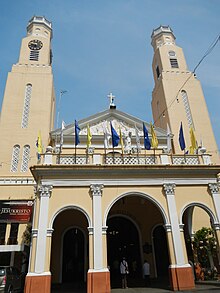San Fernando de Dilao Church
| Paco Church | |
|---|---|
| San Fernando de Dilao Parish Church Iglesia Parroquial de San Fernando de Dilao |
|

Façade of the church
|
|
| 14°42′27″N 120°59′40″E / 14.707444°N 120.994583°ECoordinates: 14°42′27″N 120°59′40″E / 14.707444°N 120.994583°E | |
| Location | Paco, Manila; Philippines |
| Country |
|
| Denomination | Roman Catholic |
| History | |
| Founded | 1580 |
| Dedication | Saint Ferdinand of Castile |
| Consecrated | 1599, 1999, 2011 |
| Cult(s) present | Nuestro Santo Padre Jesús del Sepulcro |
| Architecture | |
| Status | Parish church |
| Functional status | Active |
| Architectural type | Church building |
| Style | Neoclassical |
| Groundbreaking | 1931 |
| Specifications | |
| Number of domes | 1 |
| Number of spires | 2 |
| Materials | Sand, gravel, cement, mortar, steel |
| Administration | |
| Parish | San Fernando de Dilao Parish |
| Archdiocese | Manila |
| Province | Manila |
| Clergy | |
| Archbishop | Luis Antonio Tagle |
| Priest(s) | Rev. Msgr. Rolando R. dela Cruz |
| Assistant priest(s) | Rev. Fr. Carlo P. del Rosario Rev. Fr. Wilfredo C. Talavera Rev. Fr. Celso Alcantara Rev. Fr. Luke Moortgat, CICM Rev. Fr. John Rey Sibi |
The San Fernando de Dilao Parish Church (Tagalog: Simbahang San Fernando de Dilao ng Paco; Spanish: Iglesia Parroquial de San Fernando de Dilao) is a Roman Catholic church located in Paco, Manila, Philippines, honoring the Spanish king Saint Ferdinand III of Castile. From February 7, 2012 to April 9, 2014, the parish was used as the Pro-Cathedral of the Archdiocese of Manila, during the structural renovations of the Cathedral-Basilica of the Immaculate Conception. The church inside is notable for its romanesque-Byzantine interior with recently Italian Baroque styled Altar, most notably the Latin inscriptions similar in style to Saint Peter's Basilica in Vatican City.
The church is currently administered by its parish priest, Rev. Msgr. Rolando R. de la Cruz. In addition, the church provides active medical, dental and ENT charitable services for its poor parishioners within the community.
In 1580, the first church built was made of nipa and bamboo and was originally dedicated to Our Lady of Purification. Fr. Juan de Garrovillas of the Franciscan order has rebuilt the church using stone materials in 1599-1601. The neighbourhood's name Dilao refers to a local shrub once used to dye textiles yellow (current Filipino orthography: diláw, "yellow").
In October 3, 1603, the church was attacked and burned by Chinese during riots. It was repaired in 1606 and rebuilt with stone materials by Don Francisco Gómez de Arellano. Invading troops from the Kingdom of Great Britain burnt down the church in 1762 during their occupation of the city as part of the Seven Years' War. In 1791, a temporary church made of bamboo and nipa was erected.
...
Wikipedia

